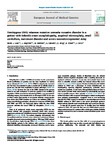Hemizygous UBA5 missense mutation unmasks recessive disorder in a patient with infantile-onset encephalopathy, acquired microcephaly, small cerebellum, movement disorder and severe neurodevelopmental delay
| dc.contributor.author | Low, KJ | |
| dc.contributor.author | Baptista, Julia | |
| dc.contributor.author | Babiker, M | |
| dc.contributor.author | Caswell, R | |
| dc.contributor.author | King, C | |
| dc.contributor.author | Ellard, S | |
| dc.contributor.author | Scurr, I | |
| dc.date.accessioned | 2022-05-03T18:22:43Z | |
| dc.date.issued | 2019-02 | |
| dc.identifier.issn | 1769-7212 | |
| dc.identifier.issn | 1878-0849 | |
| dc.identifier.uri | http://hdl.handle.net/10026.1/19171 | |
| dc.description.abstract |
Introduction Ubiquitin-fold modifier 1 (UFM1) is involved in the post-translational modification of proteins and has been implicated in various human diseases (Padala et al., 2017). UFM1 is ubiquitously expressed and has been demonstrated to play a crucial role in cellular stress response and has also been implicated in cancer pathways (Daniel and Liebau, 2014). However the role of the UFM1 cascade in the nervous system is not well understood. In order for proteins to be modified by ufmylation, UFM1 must first be activated by UBA5, a non-canonical E1 activating enzyme, then transferred to an E2 enzyme (UFC1 in the case of UFM1) before final transfer to the protein substrate. Recent studies have shown that UBA5 functions as a dimer and activates UFM1 in a unique trans-binding mechanism, whereby one monomer of UBA5 binds both UFM1 and UFC1 via C-terminal regions while the other UBA5 monomer activates the bound UFM1 by adenylation [Oweis et al., 2016]. Duan et al. performed whole exome sequencing (WES) for two Chinese siblings with progressive cerebellar ataxia with non-consanguineous parents and identified compound heterozygote variants in UBA5 (Duan et al., 2016). The authors elegantly demonstrated that Drosophila knockdown induced motor defects and a shortened lifespan alongside abnormal neuromuscular junctions. Wild type UBA5 restored the neural lesions. Again through WES, Colin et al. (2016) then identified biallelic variants in five children with a pattern of severe intellectual disability, microcephaly, movement disorders, and/or earlyonset intractable epilepsy. Studies of fibroblasts from the affected children showed impaired ufmylation with a resulting abnormal endoplasmic reticulum structure. It was also demonstrated that knockdown in zebrafish reduced motility and induced seizure like movements. Muona et al. (2016) reported 9 further individuals with biallelic variants in UBA5 and a phenotype of severe infantile-onset encephalopathy, dystonia, stagnated development, postnatal microcephaly and spasticity. In this study, CNS-specific knockout of Ufm1 in mice caused neonatal death accompanied by microcephaly and apoptosis in specific neurons. Most recently Arnadottir et al. (2017) described two sisters with compound heterozygous variants causing earlyonset epileptic encephalopathy. Altogether there is now convincing data that the UFM1 cascade is essential for neurodevelopment and that biallelic variants in UBA5 cause a rare severe phenotypic spectrum which includes infantile onset encephalopathy and movement disorder. To date all 18 reported cases from 11 families have had biallelic variants in UBA5. We report the first case of a UBA5-related neurodevelopmental syndrome in a patient with a whole gene deletion (initially detected on array-CGH) and a missense variant identified by trio exome analysis. | |
| dc.format.extent | 97-102 | |
| dc.format.medium | Print-Electronic | |
| dc.language | en | |
| dc.language.iso | eng | |
| dc.publisher | Elsevier BV | |
| dc.subject | UBA5 | |
| dc.subject | Ataxia | |
| dc.subject | Infantile-onset encephalopathy | |
| dc.subject | Whole gene deletion | |
| dc.title | Hemizygous UBA5 missense mutation unmasks recessive disorder in a patient with infantile-onset encephalopathy, acquired microcephaly, small cerebellum, movement disorder and severe neurodevelopmental delay | |
| dc.type | journal-article | |
| dc.type | Case Reports | |
| dc.type | Journal Article | |
| plymouth.author-url | https://www.webofscience.com/api/gateway?GWVersion=2&SrcApp=PARTNER_APP&SrcAuth=LinksAMR&KeyUT=WOS:000456527400005&DestLinkType=FullRecord&DestApp=ALL_WOS&UsrCustomerID=11bb513d99f797142bcfeffcc58ea008 | |
| plymouth.issue | 2 | |
| plymouth.volume | 62 | |
| plymouth.publication-status | Published | |
| plymouth.journal | European Journal of Medical Genetics | |
| dc.identifier.doi | 10.1016/j.ejmg.2018.06.009 | |
| plymouth.organisational-group | /Plymouth | |
| plymouth.organisational-group | /Plymouth/Faculty of Health | |
| plymouth.organisational-group | /Plymouth/Faculty of Health/Peninsula Medical School | |
| plymouth.organisational-group | /Plymouth/Users by role | |
| plymouth.organisational-group | /Plymouth/Users by role/Academics | |
| dc.publisher.place | Netherlands | |
| dcterms.dateAccepted | 2019-01-01 | |
| dc.rights.embargodate | 2023-10-6 | |
| dc.identifier.eissn | 1878-0849 | |
| dc.rights.embargoperiod | Not known | |
| rioxxterms.versionofrecord | 10.1016/j.ejmg.2018.06.009 | |
| rioxxterms.licenseref.uri | http://www.rioxx.net/licenses/all-rights-reserved | |
| rioxxterms.licenseref.startdate | 2019-02 | |
| rioxxterms.type | Journal Article/Review |


